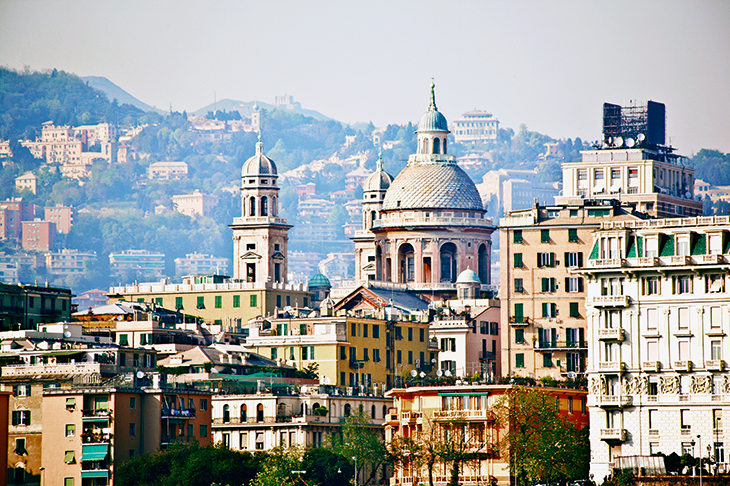Some say Genoa takes its name from Janus, the two-faced god of time and doorways. Perhaps. What’s certain is the city has two aspects: the vast industrial port, its docks the bared teeth of the Italian Riviera; and, in the ruched strip of land between the Ligurian Sea and the hills, a bewildering network of alleys, stairways, and irregular little squares. ‘Genoa is the tightest topographic tangle in the world,’ wrote Henry James, ‘which even a second visit helps you little to straighten out. In the wonderful crooked, twisting, climbing, soaring, burrowing Genoese alleys the traveller is really up to his neck in the old Italian sketchability.’
The port has sent out illustrious exports in its time. Most historians think Christopher Columbus, the son of a wool weaver, was born here and lived next to one of its medieval gates. The Genoese don’t doubt that he was, and maintain a rather desultory birthplace museum in his honour. Giuseppe Mazzini came from here too, as in some manner did jeans – a corruption of Gênes, the French name for the city.
But forget about the sea, and instead dive into those alleyways. Here is a city (James again) that ‘would be almost impossible to modernise’, in which the medieval high-rises have clung close to one another for centuries, forging a world of shadows below. The effect it has on the visitor, of disorientation alternating with discovery, can be beguiling. Genoa was once La Superba (the proud one), one of the great maritime republics alongside Venice and Pisa, with the architectural and artistic ambitions to match. There are grand buildings here, not least the dozen 16th-century palaces on the Via Garibaldi that Rubens engraved in 1622 (three now house the city’s civic art galleries). The past glory of Genoa is felt, however, not in any specific monuments, but in the accumulation of details. If you dart through the open doorway of a palazzo, you’ll probably find a baroque nymphaeum beyond; when you look up at the vaults in an old shop, there’s every chance you’ll spot blistered, salt-worn frescoes still adorning the ceiling.
Another detail: the streets here are full of dragons. From the Middle Ages onwards, the Genoese had a thing for decorated door jambs and lintels, since in the pinched, steep streets, the doorway was the best place to make a show of one’s wealth. The most desirable subject, reserved for distinguished naval captains, was the city’s patron saint, St George. In many of these reliefs, George’s adversary is a testy little monster, all sharp edges and with jaws that could take the hind leg off your stallion; above the doorway of Palazzo Cattaneo Della Volta, though, there’s a dragon that looks like an Italian greyhound asking to have its tummy tickled.
When Dickens arrived here in 1844, he found the place baffling, chaotic, even grotesque, writing that ‘the great majority of the streets are as narrow as any thoroughfare can well be, where people (even Italian people) are supposed to live and walk about’. He couldn’t fathom how one city could be home to so many ugly priests. But Genoa’s surprises soon exerted their pull, and he stayed on for months: ‘There seems to be something always to find out in it.’






Comments